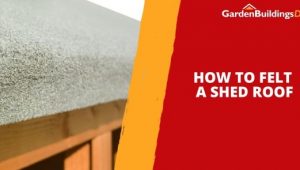Jump to:
When it comes to getting the most out of your home, nothing delivers like a garden Log Cabin can. Whether you want extra living space to extend your daily life into, a new place to relax and unwind in, or a way to use that part of your garden you rarely touch, a Cabin can be the answer.
Wondering how a log cabin differs from a summer house? Learn the key distinctions in our guide on the difference between a log cabin and a summer house.
To help you get a Cabin that brings everything you’re looking for, we’ve created this complete buying guide. With everything from sizing, wall thickness and features to roofing, flooring, insulation, security and even tips for installation, you’ll find everything you need to choose the right building for your needs and garden.
And to be clear: we’re talking about garden log cabins here, not residential ones. None of the buildings discussed here are designed as living quarters.
Use the table of contents above to find the information you need, or start exploring below!
How to Choose Your Log Cabin
When it comes to cabins, there’s a huge amount of variety in their designs, size, and more. Here at Garden Buildings Direct we have over 25 different Log Cabin models alone! There’s a Log Cabin out there that’s right for you, all you need to do is pick it out.
To help with this, we’re going to explore a number of different factors you need to consider when buying your new cabin – from purpose and size to materials, glazing, security, running costs and more.
What Purpose?
The first thing you need to decide is how you want to use your new Log Cabin, and for how much of the year. Now, don’t worry, if you want to use it for a few things at once that’s just as viable! But if you have a specific purpose in mind, like a home gym, office space or garden bar, you can narrow down your choices to models that suit the purpose and season of use.
Here are a few things that might make your chosen use easier – or harder – in certain cabins.
- How many rooms the cabin has, especially if you want separate interior spaces for work, storage or relaxation.
- The layout of the cabin’s space – if it has a narrow space, this might constrain gym equipment, larger desks or seating areas.
- How much natural light the design allows. Artists, crafters and anyone working on a screen will want as much light as possible, with control over glare.
- Accessibility, like how many doors and their position on the building. This could be important if you want to create an indoor-outdoor room or welcome clients.
Which Size?
When it comes to buying garden buildings, size does matter. Not only is it important for how you want to use the building, but it’s crucial that you pick a cabin size that fits your garden space and meets any height or planning limits.
To get this right, you’ll first need to measure up the dimensions of the place you’re intending to put your cabin. Get the dimensions of both the total area, including the height or if there are any obstructions, as well as the space you’d ideally want the cabin to take up. This will help you get a complete idea of what you can accommodate, inside and out.
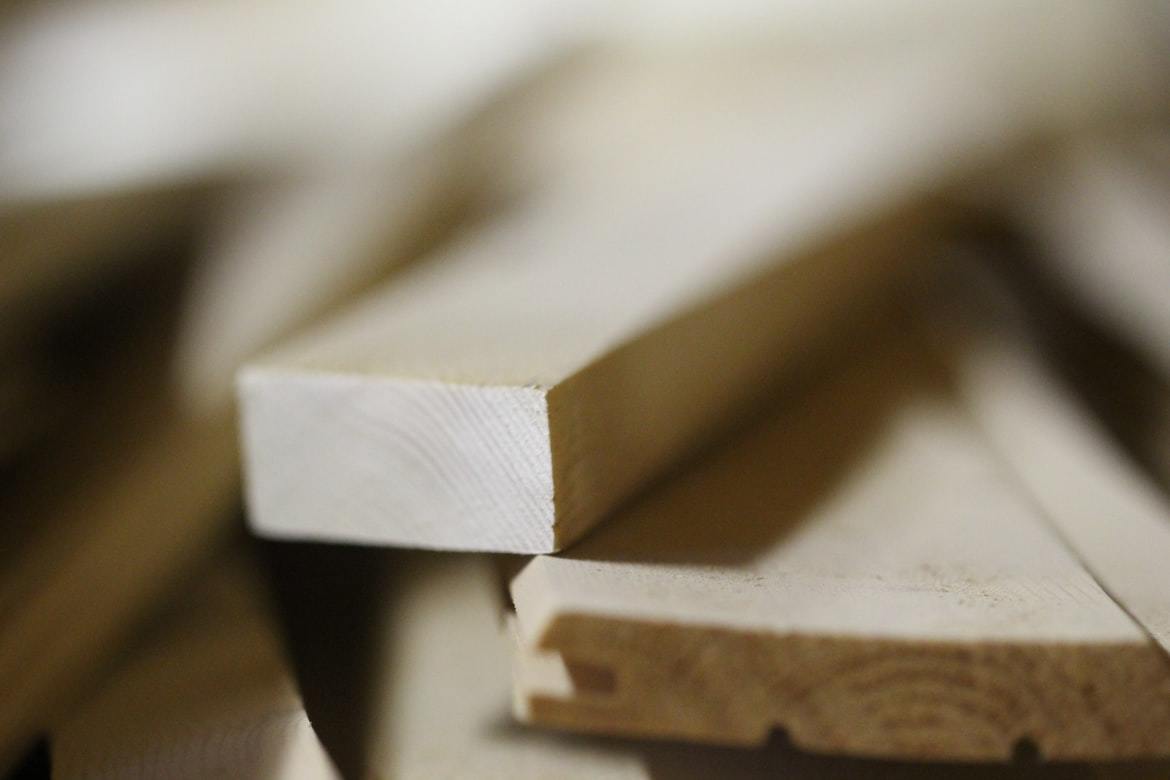
For help narrowing down your ideal dimensions, check out our blog on what size log cabin you should buy, which breaks down popular cabin sizes and what they’re best suited for.
Log Cabin Cladding
Traditional garden log cabins (as opposed to residential or holiday log cabins) are built from log boards, stacked atop one another with a signature criss-crossing at the corners as the logs interlock.
The main decision you need to make in regards to your log cabin walls is the thickness. Not only will the type you choose have implications for the appearance and price of the cabin, but a thicker wall design will help with structural integrity and provide better insulation.
Again, you’ll want to think about the intended purpose of the cabin and whether or not you want to prioritise an insulated design. Keep in mind, too, whether the building is in a location where it could be particularly vulnerable to the elements.
We have a great choice of cladding to choose from, with walls from 19mm thick all the way up to 66mm! Check out our guide to log cabin thickness to compare options and make an informed choice.
And to learn more about insulation specifically, read our guides on:

Timber Quality & Construction
Wall thickness is only part of the story. The quality of the timber and how it’s engineered also make a big difference to how long your cabin lasts and how good it feels to use.
- Timber quality: Dense, slow-grown timber helps reduce warping and movement over time, keeping joints tight.
- Interlocking boards: Precision-cut, interlocking logs help keep out draughts and rain for a more solid, room-like feel.
- Factory treatment options: Pre-treated components give your cabin a head start in terms of protection and can extend your guarantee when maintained correctly.
All of our log cabins are designed using decades of experience in garden building design, balancing strength, weather-resistance and ease of assembly.
Which Features?
Finally, you’ll want to be sure about the features and design points you want from your new Cabin. Not only is this important for picking a cabin that helps fulfil its purpose, but for finding a cabin that looks the way you want it to. Appearance is a huge factor in selecting a building that fits into its surroundings and that you want to spend time in.
Just a few of the features and components that you’ll want to consider are:
- Roof Style. This comes down to whether you want a classic Apex roof, the similar Reverse Apex design, or a contemporary Pent-style roof that gives a modern look and can work well in smaller gardens.
- Windows and Doors. Whether you want a design with large floor-to-gable windows or smaller models for increased privacy, windows are key. Be sure that the doors you pick provide the accessibility you need, too – especially if you’re carrying gym equipment or welcoming clients.
- Pressure Treatment. On many of our cabins we offer the option of pressure treatment, which injects the wood with chemical preservatives to help reduce maintenance requirements and extend the life of your building.
- Cabin Layout and Orientation. When choosing a design, ensure that the layout of the cabin matches the space it’s intended for. For example, don’t pick a model where the door position would take you straight out into a wall!
Roofing & Roof Coverings
Your roof does more than shape the look of your cabin – it’s also your first line of defence against the weather. As well as choosing the roof style, think about the covering.
- Felt: A popular, cost-effective option that provides reliable waterproof protection for many uses.
- Felt shingles: Add a more premium look and improved durability, especially on apex and reverse apex roofs.
- Rubber or other premium coverings: On pent roofs, a single-sheet covering offers long-lasting, low-maintenance protection and fewer seams.
Glazing & Ventilation
The type of glazing and ventilation in your cabin will affect how comfortable it feels in every season.
- Single glazing: Ideal for light, seasonal use where keeping costs down is a priority.
- Double glazing: Helps retain heat, reduce noise and create a more “room-like” environment, especially in 28mm+ walls.
- uPVC frames: Offer enhanced insulation and often come with multi-point locking for additional security.
- Ventilation: Opening windows, trickle vents and regular airing help to manage moisture, reduce condensation and keep your cabin fresh – especially important for gyms, offices and salons.
Need inspiration for layouts and finishes? Explore our collection of log cabin design ideas for practical and creative ways to style your space.
Costs, Budget & Value
Finally, it’s worth thinking about how your choices affect the price of your cabin, so you get the best value for your budget.
- Size: Larger cabins cost more overall but often work out better value per square metre.
- Wall thickness: Moving up from 19mm to 28mm or 44mm increases the price but delivers a more substantial, warmer building.
- Glazing & insulation: Upgrades such as double glazing, thicker floors and insulated roofs add to the upfront cost but can save on heating and make all-year use more comfortable.
- Finishes & treatments: Pressure treatment and quality paints or stains protect your investment and can extend the lifespan of your cabin.
How to Pick the Right Cabin
Once you’ve got a complete idea of the type of Cabin that would be perfect for you – including how you’ll use it, which seasons you’ll need it in, and which features matter most – the next stage is picking it out! There are a huge number of cabins out there to pick from, especially in our range. We’ve picked out four unique models to help you get started.
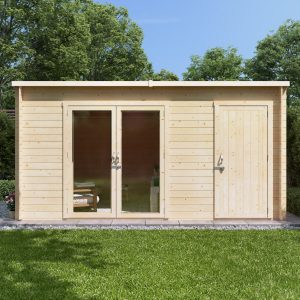 |  |
| The Tianna | The Kent |
| One of our all-time favourites, the Tianna is the ideal multi-purpose Garden Building with its blended-space design. With a configurable side store and a spacious double-door cabin room, this dual-purpose cabin provides amazing functionality in a choice of two sizes. | For those looking to create an entirely new living area, the Kent has space in bounds. Ideal as a workspace or multi-use area, the larger sizes of this building feature a multi-room design while all models have a sheltered porch area. |
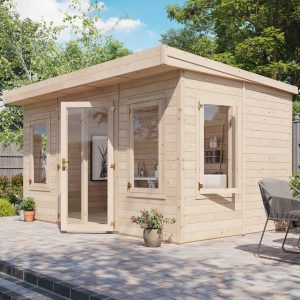 | 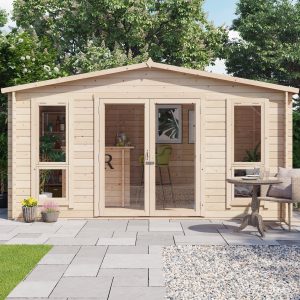 |
| The Outpost | The Sasha |
| If you’re looking for something that goes above and beyond a Log Cabin - the Outpost is for you. Built to be fully insulated by design with structurally insulated cladding and double-glazed windows, this warm, contemporary cabin is one of our premium models. | With its traditional apex roof design and large windows and glazed doors, the Sasha is a Log Cabin built for relaxation. Enjoy the airy interior, easy-to-access double doors, and beautifully classic design. |
Choose one of these fantastic models, or find the perfect building for you in our amazing Log Cabins range by clicking the button below!
Shop Log CabinsHow to Make Preparations
Once you’ve chosen your ideal garden cabin, the next step is to get everything ready in time for its construction. There are a few things you need to be sure of, and a few things to prepare, before you can get your cabin built and ready for use.
Log Cabin Planning Permission
The words Planning Permission can make anyone nervous. Nobody wants to get on the wrong side of planning law, but the good news is that it’s actually quite difficult to get anything wrong when you understand the basics.
You can read all about how, where, and why you might need planning permission for log cabins – but let’s answer the important questions below.
Can I put a Log Cabin on my Own Land?
You can certainly put a log cabin on your own land, provided it falls within the allowed parameters for an outbuilding as defined by the UK Planning Portal and is used in a way that’s incidental to the main house (for example, as an office, gym or hobby room rather than a separate dwelling).
Can I build a Log Cabin without Planning Permission?
Yes, you can build a Log Cabin without Planning Permission. Cabins and Garden Buildings will almost always fall under the category of “permitted development” under planning law. The only thing that would take them out of this category is if they exceed size limitations or specific local restrictions. Explore our guide to building a log cabin for more useful information.
What is the Maximum Size for a Log Cabin without Planning Permission?
There are a few rules for dimensions when it comes to Log Cabins. The first and most important is that the building cannot be large than 15 square metres or take up over half of your garden space.
Cabins are also limited to certain height limits – they cannot be over 4 metres tall with an Apex roof or 3 metres with a Pent roof. If the building is within 2 metres of your home, it can’t be over 2.5 metres tall.
Positioning and the Base
Setting up your cabin correctly in the spot you’ve chosen isn’t as simple as it might first seem. In particular, there are two things you need to be considering: the position or orientation of the cabin, and the base it’ll be going on.
Let’s start with positioning, as this might dictate how and where you construct your base.
The first thing to consider is where the door will go. This is probably the most important aspect of positioning – after all, if you can’t get inside, you won’t be able to use your building! You don’t just want it to be accessible, you want the door to be easy to reach and inviting. Try to place it at the end of a pathway or close to your garden door.
Windows are another thing you need to keep in mind when placing your cabin. Naturally, you’ll want them to get lots of light. If possible, face the windows southwards so they soak up light throughout the day. But also be aware of how the position affects your privacy and the line of sight or view from the window.
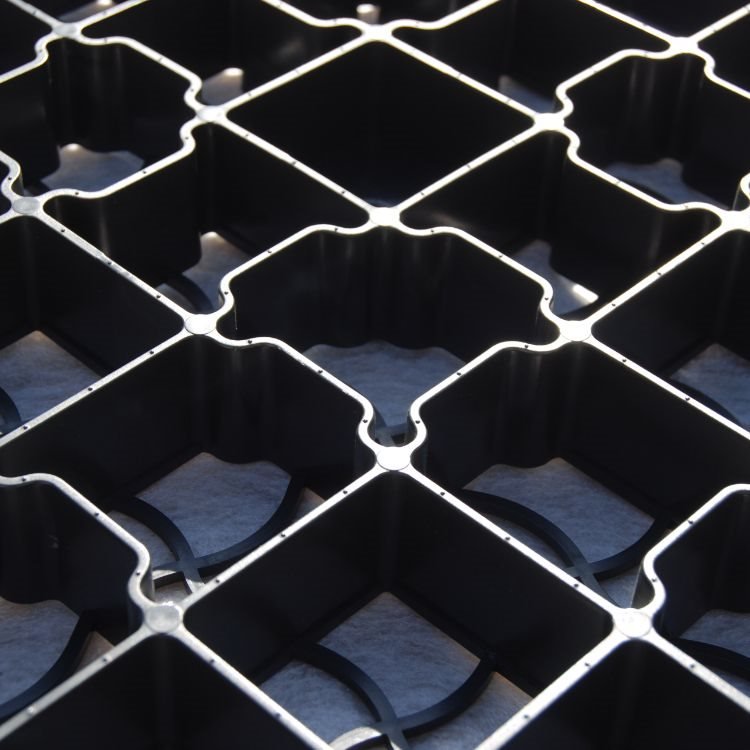
The base of your log cabin is one of the most crucial parts of a build. Get it wrong and you could be suffering from issues for the rest of its lifetime. We’ve got a whole guide on choosing and building the right base for your cabin, but to help you get the ball rolling let’s run through a few of your options.
- A concrete slab Base involves laying a concrete slab that will act as the base for your building. It’s perfect for heavier structures and, although challenging to do by yourself, is very reliable if completed correctly.
- A paved base uses paving slabs to create a solid foundation for the Log Cabin. It is cheaper than concrete and better looking, but you’ll need to ensure that the slabs and ground underneath can support the weight they’ll be holding.
- An eco base is an alternative base style that uses a grid, made of timber of plastic, filled in with gravel or stones. These kinds of bases can be easily made and disassembled but will require level ground underneath to form a flat base.
Keeping your log cabin warm
As alluded to earlier, you’ll have an easier time keeping your log cabin warm if it has thicker walls. Double glazing can also have an impact. But insulation, smart ventilation and preparation go a long way too — and with a few upgrades, you can enjoy your cabin all year round.
For step-by-step advice on improving heat retention, read our detailed guide on how to insulate a log cabin. It covers everything from choosing the right insulation materials to sealing floors, roofs, and windows effectively.
Once your insulation’s in place, you can take comfort to the next level with a few simple maintenance and heating tips. Our seasonal checklist, how to make your log cabin winter-ready, walks you through sealing draughts, managing humidity, and keeping your cabin cosy and protected through the cold months.
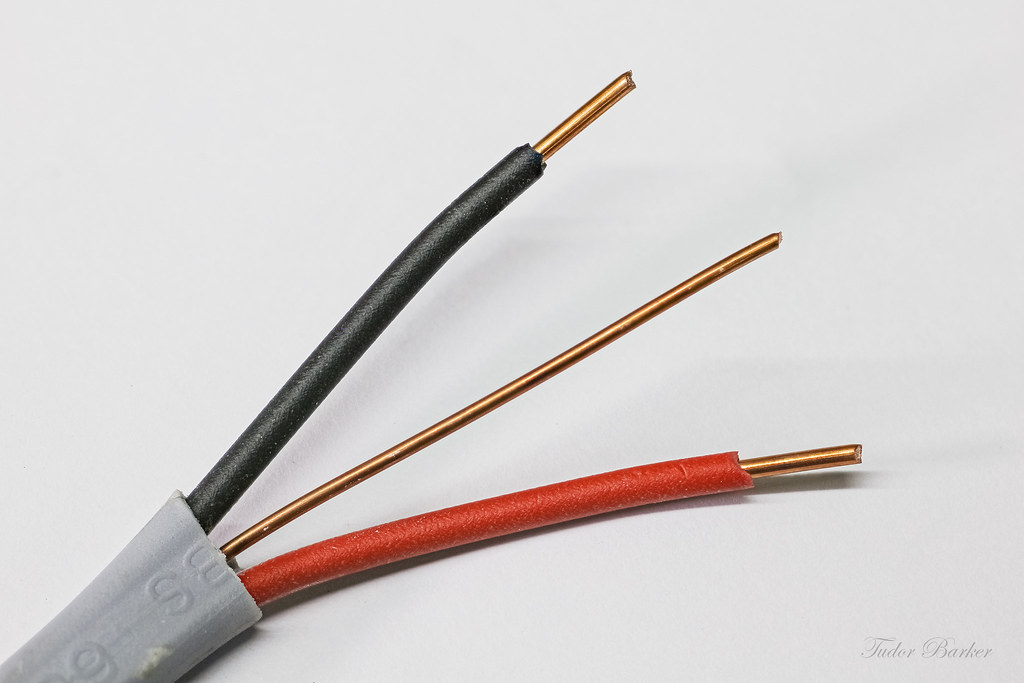
Power & Utilities
If you want to take your building up to the next level then you have the option to install utilities and an internet connection into your building. These are useful, if not vital, if you intend to use the Log cabin as a workspace or as a residence (provided you’ve got planning permission).
We’ve got two separate guides to help you achieve this – check them both out to get the low-down on setting up your log cabin for success.
How to add electricity to a log cabin
How to Install WiFi in your garden room
Security & Peace of Mind
If you’re storing valuable items such as work equipment, gym machines or gaming setups in your cabin, security is worth factoring in from the start.
- Door locks: Look for robust locks on the main doors, with multi-point locking available on many premium and uPVC door options.
- Glazing: Toughened or double glazing not only improves warmth but also adds an extra layer of security.
- Visibility: Smaller or higher windows can help keep contents out of sight from passers-by.
- Lighting & alarms: Simple additions like motion-sensor lighting or a basic alarm can be an effective deterrent.
Delivery, Access & Installation
Before your new cabin arrives, it’s important to think about how it will get from the kerbside to your base, and who will build it.
- Access route: Cabins are delivered flat-packed in sections, but you’ll still need a clear, safe route through gates and around corners to reach your base area.
- Timing: Try to have your base ready and a build day planned for as soon as possible after delivery so components can be stored safely and assembled promptly.
Installation and Our Guarantee
Our Log Cabins don’t have an installation service – simply because they don’t need one! Each of our buildings are inherently designed to be easy to build and, with at least two people working together, can be constructed quickly and effectively!
Not sure whether to build it yourself or get professional help? Our guide on whether to self-assemble or hire a builder for your log cabin explains the pros, cons, and cost considerations of both options.
Every single one of the cabins we sell comes with a 10-year protective guarantee to ensure you get great value for money. That’s a whole decade of use!
The guarantee protects the wood against rot, decay, and insect infestation. If you buy a pressure-treated model, we extend it to a fantastic 15 years to make sure you get what you deserve out of your cabin.
Maintenance & Weatherproofing
Like any timber building, a log cabin will benefit from a little regular care to keep it looking great and performing well.
- Treatment & paint: If your cabin isn’t pressure treated, apply a good-quality wood treatment or paint soon after assembly, and re-coat as recommended.
- Checks: Give your cabin a quick check once or twice a year, looking for any exposed timber, checking the roof covering and making sure water runs off and away as it should.
- Damp management: Good ventilation, sensible use of heaters and avoiding drying clothes inside for long periods all help to keep moisture in check.
You’ve now got all the information you need to make an informed decision on buying your log cabin. The only thing left…is to do it! Get out a ruler and make your measurements, make a checklist of the things you want in your building – or browse our collection of Log Cabins right now and find the one that suits you! Or, if you’re in need of a helping hand, check out our great guide to the Best Log Cabins!
Shop Log Cabins




